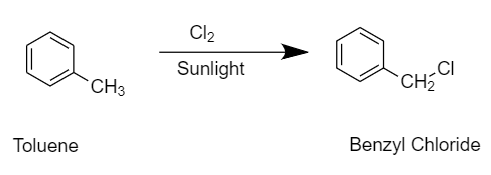
On treatment with chlorine in presence of sunlight, toluene gives:
A. $o - chloro{\text{ }}toluene$
B. $2,5 - dichloro{\text{ }}toluene$
C. $p - chloro{\text{ }}toluene$
D. $benzyl{\text{ }}chloride$
Answer
221.7k+ views
Hint:Toluene which is one of the aromatic hydrocarbons is reacted with chlorine in the presence of sunlight and since toluene is a closed cyclic structure of benzene ring with a methyl group on one of its carbon hence, a substitution reaction will take place on an alkyl group of toluene. "Arenes" and "aryl-hydrocarbons" are also used to describe hydrocarbons such as toluene and phenol.
Complete step-by-step answer:
We know that Toluene is an aromatic compound having a methyl group on the benzene ring known as methylbenzene as shown in the following figure.
Now, this reaction involves the replacement of one hydrogen atom from the methyl group in methylbenzene with a chlorine atom.
On treating toluene $\left( {{C_6}{H_6} - C{H_3}} \right)$ with chlorine $C{l_2}$ in the presence of sunlight, the product will be benzyl chloride as shown below: -

Image:Formation of Benzyl chloride
In the given reaction, when toluene is treated with chlorine in presence of sunlight, $H$ atom of the methyl group in toluene is replaced with $Cl$ atom.
Thus, on treatment with chlorine in presence of sunlight, toluene gives Benzyl chloride.
Option ‘D’ is correct
Note: The creation of benzyl chloride arises from the reaction between methyl benzene and chlorine in the presence of sunlight in this problem, which is based on aromatic hydrocarbons. The process, however, can continue and lead to the creation of benzo-trichloride by having all three hydrogen atoms in the methyl group replaced by chlorine atoms.
Complete step-by-step answer:
We know that Toluene is an aromatic compound having a methyl group on the benzene ring known as methylbenzene as shown in the following figure.
Now, this reaction involves the replacement of one hydrogen atom from the methyl group in methylbenzene with a chlorine atom.
On treating toluene $\left( {{C_6}{H_6} - C{H_3}} \right)$ with chlorine $C{l_2}$ in the presence of sunlight, the product will be benzyl chloride as shown below: -

Image:Formation of Benzyl chloride
In the given reaction, when toluene is treated with chlorine in presence of sunlight, $H$ atom of the methyl group in toluene is replaced with $Cl$ atom.
Thus, on treatment with chlorine in presence of sunlight, toluene gives Benzyl chloride.
Option ‘D’ is correct
Note: The creation of benzyl chloride arises from the reaction between methyl benzene and chlorine in the presence of sunlight in this problem, which is based on aromatic hydrocarbons. The process, however, can continue and lead to the creation of benzo-trichloride by having all three hydrogen atoms in the methyl group replaced by chlorine atoms.
Recently Updated Pages
Is PPh3 a strong ligand class 12 chemistry JEE_Main

JEE Main 2025-26 Mock Test: Organic Compounds Containing Nitrogen

JEE Main 2025-26 Organic Compounds Containing Nitrogen Mock Test

Full name of DDT is A 111trichloro22bispchlorophenyl class 12 chemistry JEE_Main

JEE Main Mock Test 2025-26: Purification & Characterisation of Organic Compounds

JEE Main Chemical Kinetics Mock Test 2025-26: Free Practice Online

Trending doubts
JEE Main 2026: Application Form Open, Exam Dates, Syllabus, Eligibility & Question Papers

Derivation of Equation of Trajectory Explained for Students

Hybridisation in Chemistry – Concept, Types & Applications

Understanding the Angle of Deviation in a Prism

How to Convert a Galvanometer into an Ammeter or Voltmeter

Degree of Dissociation: Meaning, Formula, Calculation & Uses

Other Pages
Solutions Class 12 Chemistry Chapter 1 CBSE Notes - 2025-26

NCERT Solutions For Class 12 Chemistry Chapter 1 Solutions - 2025-26

The D and F Block Elements Class 12 Chemistry Chapter 4 CBSE Notes - 2025-26

NCERT Solutions for Class 12 Chemistry Chapter Chapter 7 Alcohol Phenol and Ether

NCERT Solutions ForClass 12 Chemistry Chapter Chapter 8 Aldehydes Ketones And Carboxylic Acids

JEE Advanced Marks vs Ranks 2025: Understanding Category-wise Qualifying Marks and Previous Year Cut-offs




